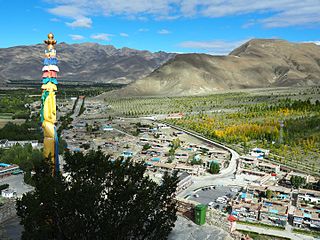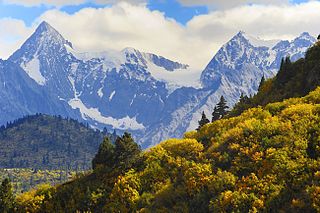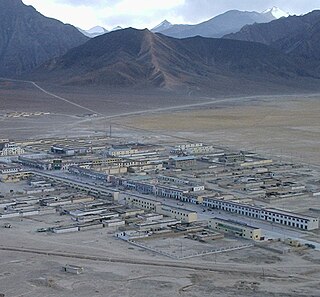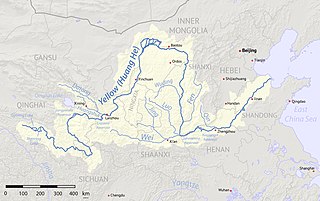
Tibet is a region in the central part of East Asia, covering much of the Tibetan Plateau and spanning about 2,500,000 km2 (970,000 sq mi). It is the homeland of the Tibetan people. Also resident on the plateau are some other ethnic groups such as the Monpa, Tamang, Qiang, Sherpa and Lhoba peoples and, since the 20th century, considerable numbers of Han Chinese and Hui settlers. Since the annexation of Tibet by the People's Republic of China in 1951, the entire plateau has been under the administration of the People's Republic of China. Tibet is divided administratively into the Tibet Autonomous Region, and parts of the Qinghai and Sichuan provinces. Tibet is also constitutionally claimed by the Republic of China as the Tibet Area since 1912.

Qinghai is a landlocked province in the northwest of the People's Republic of China. It is the largest province of China by area and has the third smallest population. Its capital and largest city is Xining.

Lake Pelku, Pelkhu, or Paiku is a lake at 4,591 meters (15,062 ft) elevation on the Tibetan Plateau in Shigatse Prefecture. It is 18 kilometers (11 mi) south of the Yarlung Tsangpo (Brahmaputra) River, bordering Saga County, Gyirong County, and Nyalam County.

Kyabje Dudjom Jigdral Yeshe Dorje was known as Terchen Drodül Lingpa and as Dudjom Rinpoche. He is considered by many Tibetan Buddhists to be from a line of important Tulku lineage, and a renowned Tertön. Per lineage, he was a direct incarnation of both Padmasambhava and Dudjom Lingpa (1835–1904). He was a Nyingma householder, yogi, and a Vajrayana and Dzogchen master. According to his disciple Khenpo Tsewang Dongyal, he was revered as "His Holiness" and as a "Master of Masters".

Shannan, also known as Lhoka, is a prefecture in the southeastern Tibet Autonomous Region, China. Shannan includes Gonggar County within its jurisdiction with Gongkar Chö Monastery, Gonggar Dzong, and Gonggar Airport all located near Gonggar town.

Ralung Monastery, located in the Tsang region of western Tibet south of Karo Pass, is the traditional seat of the Drukpa Lineage of Tibetan Buddhism. It was founded in 1180 by Tsangpa Gyare, 1st Gyalwang Drukpa, a disciple of Lingje Répa who founded the Drukpa Lineage.
Ralung is one of the most sacred places in Tibet, for it is here that the great Dugpa school of red-hat monks originated, a school still influential with numerous adherents in Southern, Northern, and Eastern Tibet, and in Bhutan, which latter country is, in fact, called Dugpa owing to the preponderance of this sect. The Ralung-til, the head monastery of the Dugpa, is to the south-east of this village. This monastery owes its name to the fact that it is surrounded by mountains as the heart (mt'il) of a lotus is by the corolla.

Pasho County or Baxoi County is a county under the administration of Chamdo Prefecture in the Tibet Autonomous Region, China. The county seat is at Pema, which is also called the "Pasho Town". The county population is 35,273 (1999). It contains the Pomda Monastery and Rakwa Tso lake.

Princess Wencheng was a member of a minor branch of the royal clan of the Tang dynasty who married King Songtsen Gampo of the Tibetan Empire in 641. She is also known by the name Gyasa or "Chinese wife" in Tibet. Some Tibetan historians consider both Princess Wencheng and Songtsen Gampo's other wife Bhrikuti to be physical manifestations of the bodhisattva Tara.

Yerpa is a monastery and a number of ancient meditation caves that used to house about 300 monks, located a short drive to the east of Lhasa, Tibet.

The Rutog Town , called Rituzhen in Chinese, is a town and the seat of Rutog County in the far western Tibet Autonomous Region. It is also a major military base for China near the disputed border with India allowing it to press its claims militarily.
Orgyen Kusum Lingpa (1934-2009) was a Tibetan terton and Nyingma lineage holder within Tibetan Buddhism. His name means "Holder of the Sanctuary of the Trikaya of Oddiyana Padmasambhava."
Gyêgu Subdistrict, formerly a part of the Gyêgu or Jiegu town is a township-level division in Yushu, Yushu TAP, Qinghai, China. The name Gyêgu is still a common name for the Yushu city proper, which include Gyêgu subdistrict and three other subdistricts evolved from the former Gyêgu town. The four subdistricts altogether forms a modern town which developed from the old Tibetan trade mart called Jyekundo or Gyêgumdo in Tibetan and most Western sources. The town is also referred to as Yushu, synonymous with the prefecture of Yushu and the city of Yushu.

Karma Gon Monastery, the original monastery of the Karma Kagyu sect of Tibetan Buddhism, was founded in the 12th century by Düsum Khyenpa, the 1st Karmapa Lama in eastern Tibet at the age of 76. Karma Gon, is located on the eastern bank of the Dzachu River in Chamdo, eastern Tibet. Karma Dansa was the cradle of the karma kagyupas. When established the Karmapa had gathered 1000 monks around him here. Karma Gon was named as Karma Dansa as an administrative unit and the Chinese Ming Court enlarged the monastery’s jurisdiction by adding the Mekong’s middle and upper reaches. It was then also called Gama Dansa Si in Chinese.

Ngawa County, or Aba or Ngaba, is a county in the northwest of Sichuan Province, China. It is under the administration of the Ngawa Tibetan and Qiang Autonomous Prefecture. It is located in the remote northwestern part of the prefecture, on the border with Qinghai and Gansu. The county seat is Ngawa Town.

Huangyuan County is a county of Qinghai Province, China, it is under the administration of the prefecture-level city of Xining, the capital of Qinghai. It is under the administration of Xining city. The county seat is Chengguan Town, known in Mongolian as Dan Gar and in Tibetan as Tongkor.

Garzê or Ganzi, is a town and county seat in Garzê County, Garzê Tibetan Autonomous Prefecture in western Sichuan Province, China. Despite Garzê Prefecture being named after the town, the prefecture capital is Kangding, 365 km to the southeast. As of 2010, Garzê was home to 16,920 inhabitants. Garzê is an ethnic Tibetan township and is located in the historical Tibetan region of Kham. It contains the 15th century Kandze Monastery, home to over 500 Gelugpa monks.
Chone Monastery, also Chone Gonchen Ganden Shedrubling, or Choni Monastery was originally a Sakya monastery. It is situated adjacent to Liulin, Jonê County, Gannan Tibetan Autonomous Prefecture, Gansu Province, China, at an altitude of about 2,610 m (8,563 ft).
Thrangu Monastery is located about 7 km south of Jyekundo in the Yushu Tibetan Autonomous Prefecture of Qinghai province, China, or the traditional Tibetan cultural region of Kham.
Gönlung Jampa Ling; Tibetan: དགོན་ལུང་བྱམས་པ་གླིང་།, Wylie: dgon lung byams pa gling; Chinese: 佑宁寺, pinyin:Yòuníng Sì ) is a Tibetan Buddhist monastery of Gelug sect in the Huzhu Tu Autonomous County of Qinghai province, China. The monastery was founded in 1604 by Gyeltse Donyo Chokyi Gyatso. Gönlung Jampa Ling housed the first Geluk seminary in Northeastern Tibet and was the seat if a number of important, high-ranking lamas including the Changkya and Thuken incarnation lineages.

The Huangshui River or Huang Shui is a river in Qinghai and Gansu, China. The river is a left tributary of the Yellow River and its total length is 374 km (232 mi) with a basin area of 3,200 km2 (1,200 sq mi).














